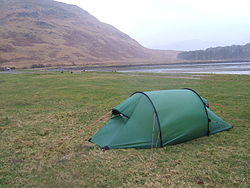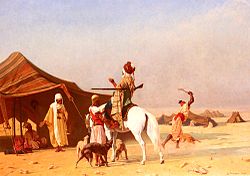Difference between revisions of "AY Honors/Camping/Tent/Styles/es"
(Created page with "{{clear}}") |
(Created page with "{{clear}}") |
||
| Line 32: | Line 32: | ||
{{clear}} | {{clear}} | ||
| − | + | {{clear}} | |
| − | + | {{clear}} | |
:The basic dome design has been modified extensively, producing tents with three poles, tents with irregularly-shaped bases, and other unusual types. A common variation is to add a third pole going from corner to corner on one side; this is angled away from the tent, and supports an extended flysheet or outer tent to give a porch/storage area. | :The basic dome design has been modified extensively, producing tents with three poles, tents with irregularly-shaped bases, and other unusual types. A common variation is to add a third pole going from corner to corner on one side; this is angled away from the tent, and supports an extended flysheet or outer tent to give a porch/storage area. | ||
Revision as of 21:41, 10 November 2014
Con los materiales modernos disponibles hoy en día, los fabricantes de tiendas de campaña tienen la capacidad de cambiar las clases, los estilos y las formas de sus tiendas de campaña.
- Las varillas de la tienda mantienen la forma de la tienda.
- Las varillas se pueden desmantelar para que puedan ser transportadas con facilidad, tienen un código de colores y/o están unidas por cadena o una cuerda, para que sea más fácil de levantar una tienda de campaña.
- Se necesita muy pocas cuerdas tensoras para atar a la tienda (a veces ninguna).
- Colocación exacta de los tensores es innecesaria.
Por su tamaño
- Ratoneras. Son muy pequeñas y ligeras, para una o dos personas máximo.
- Convencionales. Son para entre dos y 5 personas, tienen varias formas y varían más bien solo en las dimensiones de acuerdo con su capacidad.
De las convencionales se distinguen dos tipos principales:
- Canadiense: de planta rectangular (las más completas tienen su parte trasera redondeada en forma de ábside) están sostenidas por dos mástiles o "parantes" y poseen un sobretecho (fue el tipo de tienda de campaña más común en la segunda mitad del siglo XX).
- Iglú, esta tienda de campaña es la más usada desde el último cuarto del siglo XX y en la actualidad, como su nombre lo indica se basa en el diseño de un iglú "esquimal" o inuit al tener forma de domo y poseer los "parantes" portantes desde el mismo techo de la estructura lo que le da la gran ventaja sobre la tienda o carpa canadiense de no tener obstáculos en su interior y ser más aerodinámica e hidrodinámica, por otra parte las tiendas o carpas del tipo "iglu" merced a los materiales con que son hechas son mucho más livianas que las canadienses, plegadas y embolsadas para transportarlas ocupan mucho menos espacio y suelen ser más fáciles y rápidas de armar.
- Grandes. Están destinadas a albergar a personas paradas, son amplias y grandes, se utilizan como habitación múltiple, cocina u otra función.
Por clima
thumb|250px|Carpa de cuatro estaciones. De acuerdo con su capacidad para brindar comodidad y aislar su interior de los elementos naturales las tiendas de campaña se caracterizan por estaciones, refiriéndose a las estaciones del año.
- Primavera. Capacidad para resistir la lluvia.
- Verano. Capacidad para soportar el sol.
- Otoño. Capacidad para resistir el viento.
- Invierno. Capacidad para soportar el frío.
Así una tienda puede ser de una estación particular, de dos, de tres o de cuatro estaciones, de acuerdo con su diseño y materiales.
- The basic dome design has been modified extensively, producing tents with three poles, tents with irregularly-shaped bases, and other unusual types. A common variation is to add a third pole going from corner to corner on one side; this is angled away from the tent, and supports an extended flysheet or outer tent to give a porch/storage area.
- Tunnel tents may offer more usable internal space than a dome tent with the same ground area, but almost always need guy ropes and pegs to stay upright. These are almost always double wall tents. Sizes range from 1-person tents with very limited headroom up to 8 or 10-person tents with headroom exceeding 180 cm (6 ft). Tunnel tents have a low end profile making them great for high wind situations.
- A basic tunnel tent uses three flexible poles, arranged as three parallel hoops, with tent fabric attached to form a tunnel. The most common designs have a sleeping area at one end and a porch/storage/living area at the other. Smaller designs may use only 2 poles and larger designs may use 4 poles; the latter may have a sleeping area at each end and a living area in the middle.
- Hybrid dome/tunnel tents are now common. One variation is to use a basic dome as the sleeping area; one or two hooped poles to one side are linked by a tunnel to the dome to provide a porch. Another variation is to use a large dome as the living area, with up to 4 tunnel extensions to provide sleeping areas.
- Geodesic tents are essentially dome tents with 2 or more extra poles which criss-cross the normal two poles to help support the basic shape and minimise the amount of unsupported fabric. This makes them more suitable for use in snowy conditions. To help withstand strong winds they are rarely more than 120 or 150 cm high (4 to 5 ft).
- Single-hoop tents use just one flexible pole and are often sold as light-weight 1 or 2-person tents. These are the modern equivalent of older style pup tents, and have the same feature of somewhat limited headroom. Different styles may have the pole going either along or across the tent.
Older Tent Styles
Most of these tent styles are no longer generally available. Most of these are single-skin designs, with optional fly sheets for the ridge tents.
All the tents listed here had a canvas fabric and used a substantial number of guy ropes (8 to 18). The guys had to be positioned and tensioned fairly precisely in order to pitch the tent correctly, so some training and experience were needed. This made these styles relatively unsuitable for casual or occasional campers. Pup tents might use wooden or metal poles, but all the other styles mentioned here used wooden poles.
- A pup tent is a small version of a ridge tent intended for 2 or 3 people. It usually has a rectangular floor of size ranging from 4 ft by 6 ft up to 6 ft by 8 ft, and ridge heights ranging from 3 ft up to 5 ft. The side walls are usually about 1 ft high. There are guy ropes for each pole, at each corner, and in the centre of each side, and these guy ropes help to maintain the required shape. Earlier versions had a single upright pole at each end, while later versions often have two poles at each end, arranged rather like an 'A' shape, in order to make access easier. Some models have a horizontal ridge pole joining the tops of the end poles to support the centre of the tent.
- A ridge tent can sleep 5 to 8 people. They usually have a rectangular floor of size ranging from 8 ft by 10 ft up to 10 ft by 16 ft, and ridge heights around 6 ft to 7 ft. The side walls are usually about 3 ft high. They normally have a single upright pole at each end with the tops joined by a horizontal ridge pole. Longer models might have an additional upright pole in the centre to help support the ridge pole. They often have two guy ropes at each corner, and guy ropes every 2 ft along the sides. If strong winds are expected then two additional storm guy ropes are attached to the top of each pole.
- A square centre-pole tent was often used for family camping in the first half of the 20th century. Despite the use of 9 poles and 12 guy ropes, such a tent could be pitched by an (experienced) family of four in some 10 to 15 minutes. These tents had a square floor of size ranging from 8 by 8 ft up to 15 by 15 ft. There were poles about 5 ft high at each corner and in the middle of each side, and a 10 ft or 12 ft pole in the centre - the walls were vertical and the roof was pyramid-shaped, so there was plenty of headroom over most of the tent.
- A Sibley tent (bell tent) had a circular floor plan some 10 ft to 15 ft across, a single central pole some 10 ft high, and walls about 3 ft high. Guy ropes were connected every 2 ft around the top of the walls - these had to carefully tensioned to hold the pole upright and keep the tent in shape.


